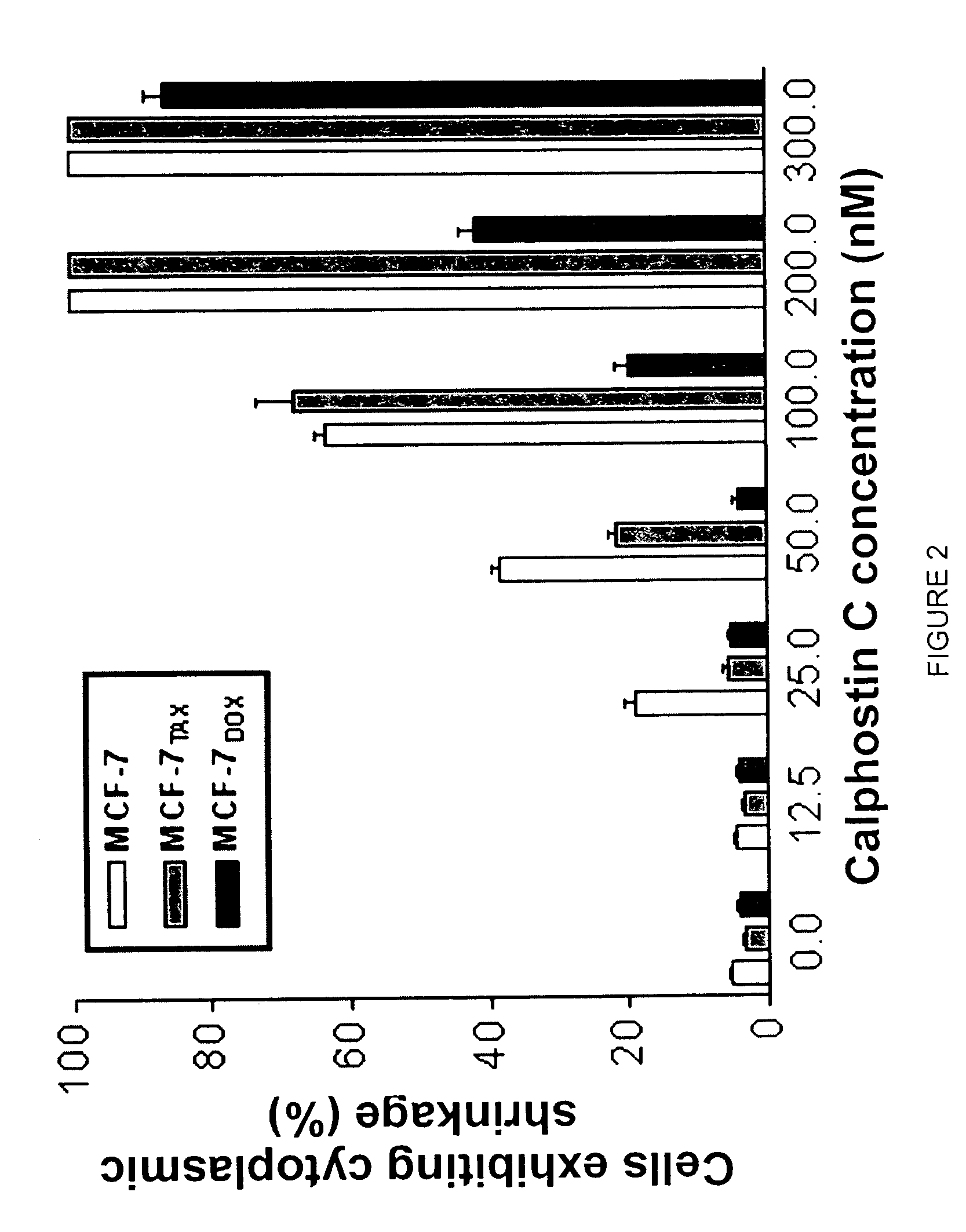Use of calphostin C to treat drug-resistant tumor cells
a tumor cell and calphostin technology, applied in the field of medicinal chemistry, can solve the problems of drug-resistant tumor cells, valspodar could only partially restore the cytotoxicity of doxorubicin, and the cross-resistance to a variety of structurally unrelated drugs,
- Summary
- Abstract
- Description
- Claims
- Application Information
AI Technical Summary
Benefits of technology
Problems solved by technology
Method used
Image
Examples
example 1
Establishment of MCF-7TAX and MCF-7DOX Cell Lines
[0036]After selection using the dose escalation protocol described above, paclitaxel- and doxorubicin-resistant cell lines (MCF-7TAX and MCF-7DOX cells, respectively) were established. The concentration of drug required to kill or inhibit the growth of 50% of MCF-7 cells (the IC50) Was 0.5 nM for paclitaxel and 10 nM for doxorubicin. In contrast, the IC50 of MCF-7TAX cells for paclitaxel was 27 nM which is 54-fold higher than that for MCF-7 cells (FIG. 1A). Similarly, when MCF-7 cells acquired resistance to doxorubicin, the IC50 of MCF-7DOX cells for doxorubicin increased 60-fold to 600 nM (FIG. 1B). Therefore a similar range of resistance was achieved for the two cell lines to their respective drugs.
example 2
Calphostin C can Effectively Kill both MCF-7TAX and MCF-7DOX Cells
[0037]The ability of calphostin C to kill MCF-7TAX and MCF-7DOX cells was then examined using a clonogenic assay. As shown in FIG. 1C, calphostin C killed MCF-7TAX cells as effectively as parental MCF-7 cells. The IC50's were 13.2 nM and 9.2 nM for MCF-7 and MCF-7TAX cells, respectively. The induction of cell death was somewhat less effective for MCF-7DOX cells, which had an IC50 for calphostin C of 64.2 nM. Thus, MCF-7DOX cells were approximately 5-fold less sensitive to calphostin C than MCF-7 cells. Nevertheless, the above data is strongly predictive that calphostin C may be useful for inhibiting the growth of breast tumor cells after the establishment of paclitaxel or doxorubicin resistance. This is particularly noteworthy considering the observation that MCF-7DOX cells are approximately 4000-fold cross-resistant to paclitaxel.
[0038]The above findings were further supported by measurement of calphostin C-induced c...
example 3
Morphology of Paclitaxel- or Doxorubicin-Treated MCF-7 Cells
[0039]In contrast to control cells (FIGS. 3A, 3E, and 3I), MCF-7 cells treated for 24 hours with 10 nM paclitaxel became round (hence, their unfocussed appearance) and / or detached from their culture dishes (FIGS. 3B and 3F), consistent with the action of paclitaxel as an inducer of cell cycle arrest during mitosis [44, 45]. While most of the paclitaxel-treated cells could not be stained with PI due to their detachment from coverslips during washing and staining, over 60% of adherent cells were clearly multinucleated, possessing numerous small nuclei (FIG. 3J). Multinucleation is exhibited in a number of cell lines upon treatment with paclitaxel [46, 47], including MCF-7 cells [48]. Detached paclitaxel-treated MCF-7 cells, when introduced into drug-free medium, re-adhered to the culture dish, retained their multinucleated phenotype, but could not undergo subsequent cell division (data not shown). In contrast, MCF-7 cells tre...
PUM
| Property | Measurement | Unit |
|---|---|---|
| distance | aaaaa | aaaaa |
| pH | aaaaa | aaaaa |
| pH | aaaaa | aaaaa |
Abstract
Description
Claims
Application Information
 Login to View More
Login to View More - R&D
- Intellectual Property
- Life Sciences
- Materials
- Tech Scout
- Unparalleled Data Quality
- Higher Quality Content
- 60% Fewer Hallucinations
Browse by: Latest US Patents, China's latest patents, Technical Efficacy Thesaurus, Application Domain, Technology Topic, Popular Technical Reports.
© 2025 PatSnap. All rights reserved.Legal|Privacy policy|Modern Slavery Act Transparency Statement|Sitemap|About US| Contact US: help@patsnap.com



